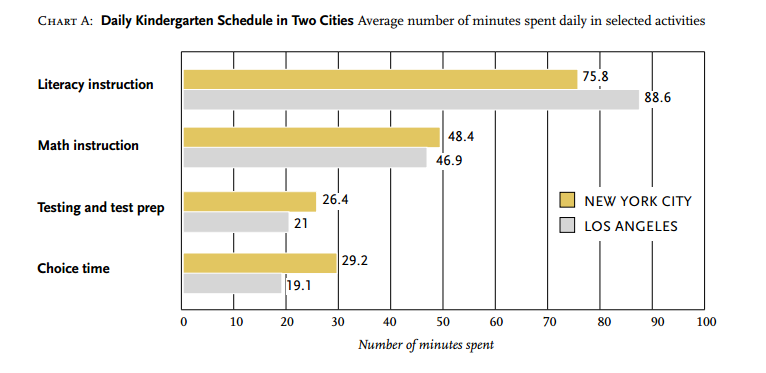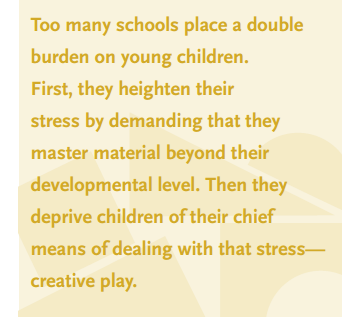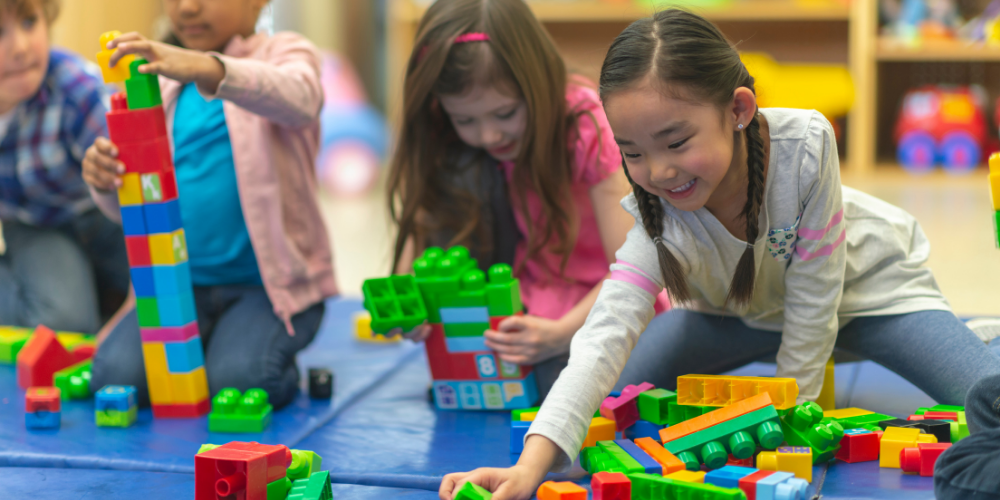This week’s blog post writer, Susanne Leslie, is a Curriculum & Instruction Specialist with Teaching Channel. Prior to joining the Teaching Channel, Susanne worked as a Parent Educator in Early Childhood Family Education (ECFE) with parents of 0-5 year olds which, we think, gives her special insight into the importance of being little. Susanne is the proud parent of two daughters.
“Children are designed, by natural selection, to play.”
-Peter Gray, The Decline of Play and the Rise of Psychopathology in Children and Adolescents
Polar bears in zoos repeat their movements. Standing outside their paint-chipped pens, zoo goers watch as two ton bears dive into the water, climb out, pace, repeat. Over and over again these majestic bears demonstrate what being caged does to an animal designed for movement and activity.
On a recent trip to St. Paul, Minnesota, I listened to Katy Smith—a native Minnesotan, parent educator, and 2011 Teacher of the Year share this story to a room packed with educators hungry to find answers about how teachers can bring play back into their classrooms and to discuss the importance of play in the classroom. As she spoke, there on the screen in front of us: a picture of a polar bear.
In my former role as a Parent Educator, I was given both the opportunity and the responsibility–to breakdown what children were learning in the early childhood classroom and to remind parents and administrators alike of the importance of play in early childhood.
With parents gathered at the observation window, we observed…
- Explored their imaginations in the dramatic play area, dressing up and pretending to be teachers, doctors, fire fighters. Some taking charge and leading, others following
- Discovered the “give-and-take” of friendship, like playing cooperatively and practicing giving directions and asking questions
- Grew in their understanding about consequences when they were forceful, quiet, boisterous, or if they didn’t share, or take turns
- Scooped, poured, measured at the sensory table, learning about cause and effect, physics in action
- Blew bubbles outside into the cold air, estimating how long the bubbles would take to freeze, science and predictions
- Squeezed, rolled, picked up, and sliced the colorful Play-Doh and “goop,” designed to develop hand strength needed for grasping and writing
- Climbed, reached, ran, and soared- acquiring strength, agility,and dexterity, using their designed-to-move bodies as they made brain and body connections
- Paged through books looking at pictures, pretending to read and growing more confident with words and sounds
- Combining, taking away, or adding blocks, guessing how many would fit in an area, learning about spatial relationships and math
- Swirled and swayed to music, learning kinesthetically, and discovering the mechanics of movement
Play is not more important than science, literacy, physics, and math. It IS science, literacy, physics, and math.
- If playing is happening in my classroom I am looked down upon
- I’ve been told my students should be in their seats doing pencil and paperwork to prepare for first grade
- Pressure not to play often came from principals whose background was in high school teaching and had no experience with early childhood education
- An administrator told me “You are going to stop singing and start teaching, right?”
- Teachers feel pressure to call play centers “developmental centers,” “work centers” or to describe play as “active learning”
- A teacher suggested that dramatic play centers should be removed from kindergarten classrooms because “there is a time crunch and not enough time for play”
Why then is play the first thing to go?
Despite the benefits and research supporting play in the classroom schools have seen a steady decline in the amount of time devoted to play.
There are two types of play: social play and physical play. Social play helps children learn to cooperate and teaches how to deal with conflict and emotions. Through social play, children learn they must work to get along with others, and, even if they are the most skilled player, they won’t have anyone with whom to play if they do not play fairly.
“Social play makes children happy, and its absence makes them unhappy.” – (Gray, 2011)
Physical play teaches children how to manage activities that create fear—and they learn how much, or how little, fear they can tolerate. If there is too much, they stop enjoying the activity, and if there is not enough, they grow bored. But, only the child can make that decision; another reason why play must be the kind where the children make decisions for themselves.
“A fundamental characteristic of play is that it is directed and controlled by the players themselves.” (Miller & Almon, 2009)
“Today, in many neighborhoods, it is hard to find groups of children outdoors at all, and, if you do find them, they are likely to be wearing uniforms and following the directions of coaches while their parents dutifully watch and cheer.” (Miller & Almon, 2009)
Testing, NCLB, lack of support from administrators, judgment from colleagues, parental expectations and an absence of understanding about child development combine to make it challenging for teachers to make a stance for play—as evidenced in the following teacher comments:
- If playing is happening in my classroom I am looked down upon
- I’ve been told my students should be in their seats doing pencil and paper work to prepare for first grade
- Pressure not to play often came from principals whose background was in high school teaching and have no experience with early childhood education
- An administrator told me “you are going to stop singing and start teaching, right?”
- Teachers feel pressure to call play centers “developmental centers,” “work centers” or to describe play as “active learning”
- A teacher suggested that dramatic play centers should be removed from kindergarten classrooms because “there is a time crunch and not enough time to spend on things.” (Gray 2011; Lynch 2015)
On the other hand, there were teachers who noted:
- Feeling fortunate to be in a school where play is still the centerpiece of kindergarten education
- Feeling blessed to have an administrator with a background in early childhood education
- Feeling glad to be in a district that recognizes the importance of play (Gray 2011; Lynch 2015)
Losing play in the classroom is having detrimental effects on children. One first grade teacher noted that students are arriving in the classroom with weak hand control, unable to grasp—and to which he attributes to the loss of play—specifically, the removal of manipulatives like Play-Doh—used to increase hand strength in preschoolers. Instead, educators are feeling the burden of ever increasing sit-still time, specifically literacy instruction, math instruction, testing and test prep.

(Miller & Almon, 2009)
Educators are being asked to teach their young students things they are not yet developmentally ready to learn. They learn through play.

(Miller & Almon, 2009)
In A Whole New Mind: Why Right Brainers Will Rule the Future, author Daniel Pink discusses artistic, empathetic and playful abilities—and emphasizes the need for opportunities for creativity and play throughout childhood. Pink describes our future economy as an “imagination economy” and warns that without the opportunities for play, our children will find the future challenging. Pink states “people have to be able to do something that can’t be outsourced, something that’s hard to automate and that delivers on the growing demand for things that require our imagination.” (Pink, 2006).
One company, leading the way with a creative and playful work environment is Google. Explore the Google campus (other companies are following Google’s lead) and you will see a workplace where creativity is championed. Lego stations, Tinker-Toy-like work stations and scooters are just three examples of what you find at Google. They understand “Google’s success depends on innovation and collaboration” and that many ideas are born of creativity and play.
“Whatever the brain is doing while apparently doing nothing may actually be profoundly important.” –Unknown
“Sitting still and being quiet is not a marketable job skill.” –Lisa Murphy
“It was a failure of our imaginations.” – Henry Kissinger in reference to 9/11
In a report from The Alliance for Childhood, loss of play is contributing to an increase in aggression and anger in young children. Play allows children opportunities for self-education and self-regulation—without these opportunities to practice, children are finding it difficult to control their emotions and impulses. (Miller & Almon, 2009).
In addition, the United States is in the midst of an obesity epidemic. As we chip away at play in the classroom, take away recess and physical education, and feed our students nutritionally bankrupt meals—it is easy to make the connection. The Center for Disease Control reports 12.7 million—or 1 in 6–children and adolescents are affected by obesity. (CDC, 2015)
Play can be a tough concept to grasp if one has never played. Self-directed play can feel foreign to young teachers who grew up with cell phones and organized sports. It’s important for our students, and it is just as important for us. Teach yourself to play, too! (Miller & Almon, 2009).
Become a Play Warrior.
Learn about it.
If you need a place to start, check out the book Play: The Foundation of Children’s Learning by Lisa Murphy. Our own beliefs about play influence public policy. So, take the time to learn about its importance, and what it teaches.
Read about play from authors and play advocates like:
Bev Bos, Michael Leeman, Tom Hunter, Dan Hodgins, Jenny Chapman, Cynde Scrimger Nichols, Sharron Krull, Barb Chernofsky, and Alfie Kohn. (Murphy, 2016).
Ensure play follows the four developmentally appropriate domains: cognitive development, language/literacy development, physical (fine and gross motor) development, and social/emotional development.(Murphy, 2016).
Talk about it.
Communicate with colleagues, parents, children, friends and family to ensure they understand play helps children to:
- Develop intrinsic interests and competencies
- Learn how to make decisions, solve problems, exert self-control, and follow rules
- Learn to regulate their emotions
- Make friends and learn to get along with others as equals
- Experience joy
(Murphy, 2016).
Talk to your state representatives, your principal, your school board.
Do it.
Tomorrow…
Break out the Play-Doh, or take your students outdoors for a nature hike. Play music and encourage them to sing along or dance. Tape a giant sheet of paper on the floor and ask your students to paint a story. Explain a concept like H20 using your students (2 students represent hydrogen, one represents oxygen) or to demonstrate addition and subtraction.
PLAY!
Looking for additional ways to incorporate play in the classroom? Watch this recorded conversation with Minnesota’s own Katy Smith–parent educator and Minnesota Teacher of the Year! In this on-demand webinar, Katy discusses what the research says about the importance of play in early childhood education, how loss of play is affecting our students, her ideas for getting play back into the classroom, and how YOU can become a play advocate!
References:
- At Google a Place to Work and Play (2012, March 16). Retrieved from http://www.nytimes.com/2013/03/16/business/at-google-a-place-to-work-and-play.html Retrieved 12/2016.
- Childhood Obesity Data. Center for Disease Control. Retrieved from https://www.cdc.gov/obesity/data/childhood.html Retrieved 12/2016.
- Dodge, T. D. (2010). Research Foundation: The Creative Curriculum. www.teachingstrategies.com
- Gray, P. (2011). The Decline of Play and the Rise of Psychopathology in Children and Adolescents. American Journal of Play. www.journalofplay.org
- Lewis, L. (2016). Play: The foundation of children’s learning. Red Leaf Press. St. Paul, MN.
- Lynch, M. (2015). More Play, Please: The perspective of kindergarten teachers on play in the classroom. American Journal of Play. www.journalofplay.org
- Miller, E. & Almon, J. Alliance for Childhood. Crisis in the Kindergarten: Why children need to play in school. www.allianceforchildhood.org Retrieved 12/2016.
- Pink, D. (2006). A Whole New Mind: Why right brainers will rule the future. Penguin Group. New York, NY







